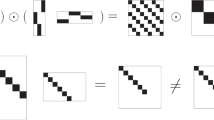Abstract
The linear Schrödinger equation is generalized into non-linear equation based on the Gauss' principle of least squares. The weight function is assigned in such a way that it might be interpreted as occupation number density of hidden particles that obey the Fermi–Dirac stastistics. It is shown that the motion of a free particle, according to the so generalized non-linear equation, is described by a well behaved nondeforming wave packet moving with a constant velocity, in contrast to the always deforming wave packet according to the linear Schrödinger equation.
Similar content being viewed by others
REFERENCES
L. de Broglie, Non-Linear Wave Mechanics (Elsevier, Amsterdam, 1960).
E. Schrödinger, “Der stetige Übergang von der Mikro-zur-Makro mechanik,” Naturwiss. 14, 664-666 (1926).
S. Howard and S. K. Roy, “Coherent states of a harmonic oscillator,” Am. J. Phys. 55, 1109-1117 (1987).
W. M. Zhang, D. H. Feng, and R. Gilmore, “Coherent states theory and some applications,” Rev. Mod. Phys. 62 867-927 (1990).
D. F. Styer, “The motion of wave packects through their expectation values and uncertainties,” Am. J. Phys. 58 742-744 (1990).
C. C. Yan, “Soliton-like solutions of the Schrödinger equation for simple harmonic oscillator,” Am. J. Phys. 62 147-151 (1994).
D. Bohm, “A suggested interpretation of the quantum theory in terms of 'hidden' variables I,” Phys. Rev. 85, 166-179 (1952); “A suggested interpretation of the quantum theory in terms of 'hidden' variables II,” Phys. Rev. 85, 180–193 (1952).
A. C. Scott, F. Y. Y. Chu, and D. W. McLaughlin, “The soliton: A new concept in applied sciences,” Proc. IEEE 61, 1443-1483 (1973).
L. D. Faddeev and L. A. Takhtajan, Harniltonian Methods in the Theory of Soliton (Springer, Berlin, 1987).
B. Mielnik, “Generalized quantum mechanics,” Commun. Math. Phys. 37, 221-256 (1974).
I. Bialynick-Birula and J. Mycielski, “Nonlinear wave mechanics,” Ann. Phys. 100, 62-93 (1976).
R. Haag and U. Bannier, “Comments on Mielnik's generalized (non-linear) quantum mechanics,” Commun. Math. Phys. 60, 1-6 (1978).
T. W. B. Kibble, “Relativistic models of nonlinear quantum mechanics,” Commun. Math. Phys. 64, 73-82 (1978).
S. Weinberg, “Testing quantum mechanics,” Ann. Phys. 194, 336-386 (1989).
C. C. Yan, “Hamilton's principle and Schrödinger's equation derived from Gauss' principle of of least squares,” Found. Phys. Lett. 13, 79-87 (2000).
Author information
Authors and Affiliations
Rights and permissions
About this article
Cite this article
Yan, C.C. A POSSIBLE GENERALIZATION OF THE SCHRÖDINGER EQUATION BASED ON THE GAUSS PRINCIPLE OF LEAST SQUARES. Found Phys Lett 13, 369–378 (2000). https://doi.org/10.1023/A:1007823728164
Published:
Issue Date:
DOI: https://doi.org/10.1023/A:1007823728164




